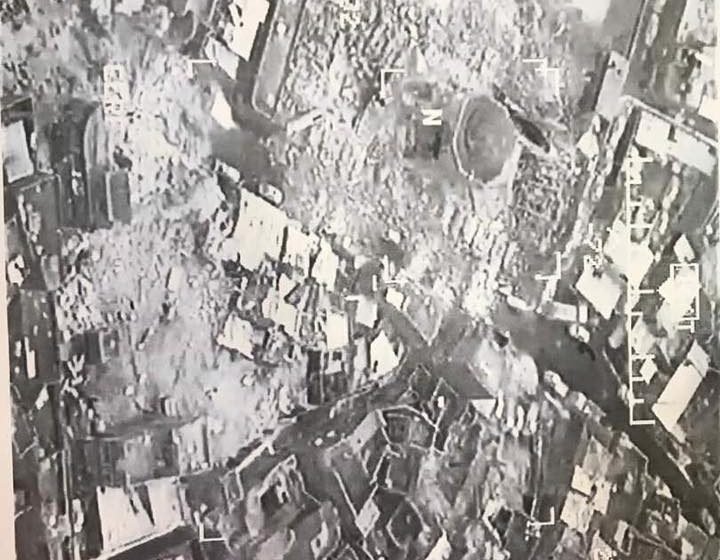UPDATED: U.S., Islamic State exchange blame for Mosul’s historic minaret bombing

An aerial view image from the Iraqi Defense Ministry’s media office shows the aftermath of Islamic State’s bombing of the historic Hadbaa (leaning) minaret in western Mosul

Mosul/Erbil (IraqiNews.com/Reuters) Islamic State militants and the United States exchanged accusations for the destruction of the minaret of Mosul’s oldest mosque on Wednesday.
A senior U.S. general in Iraq called Islamic State militants’ destruction of the Grand al-Nuri Mosque of Mosul and its famous leaning minaret “a crime against the people of Mosul and all of Iraq.”
“The responsibility of this devastation is laid firmly at the doorstep of ISIS,” Army Major General Joseph Martin, who leads the U.S.-led coalition’s combined joint forces land component, using an acronym for Islamic State.
Islamic State, meanwhile, in a statement circulated across media reports, blamed U.S.-led coalition warplanes for the bombing of the minaret.
It was from this medieval mosque that the militants’ leader Abu Bakr al-Baghdadi declared a self-styled “caliphate” spanning parts of Syria and Iraq three years ago.
Islamic State’s Amaq news agency accused American aircraft of destroying the mosque.
The Iraqi military’s media office distributed a picture taken from the air that appears to show the mosque and minaret flattened in the middle of the small houses of the Old City, the historic district where the militants are besieged.

“The Daesh (Islamic State) terror gangs committed another historical crime by blowing up the al-Nuri mosque and its historical al-Hadba minaret,” the Iraqi military statement said.
The explosions happened as Iraq’s elite Counter Terrorism Service units, which have been battling their way through Mosul’s Old City, got to within 50 meters (164 ft) of the mosque, the statement said.
Iraqi forces earlier on Wednesday said they had started a push towards the mosque. A U.S.-led coalition is providing air and ground support to the Mosul offensive which began in October 2016.
The forces had encircled on Tuesday the jihadist group’s stronghold in the Old City, the last district under their control in Mosul.
Al-Baghdadi proclaimed himself “caliph”, or ruler of all Muslims, from the pulpit of the mosque on July 4, 2014, after the insurgents overran parts of Iraq and Syria.
His black flag had been flying over its 150-foot (45-metre)leaning minaret since June 2014.
Baghdadi’s speech from the mosque was also the first time he revealed himself to the world, and the footage broadcast then is to this day the only film recording of him.
MINARET WAS VULNERABLE
Iraqi officials had privately expressed the hope that the mosque could be captured in time for Eid al-Fitr, the festival marking the end of Ramadan, the Muslim fasting month. The first day of the Eid falls this year on June 25 or 26 in Iraq.
The fall of Mosul would, in effect, mark the end of the Iraqi half of the “caliphate” even though Islamic State would continue to control territory west and south of the city, the largest they had control of in both Iraq and Syria.
Baghdadi has left the fighting in Mosul to local commanders and is believed to be hiding in the border area between Iraq and Syria, according to U.S. and Iraqi military sources.
The mosque is named after Nuruddin al‑Zanki, a noble who fought the early crusades from a fiefdom that covered territory in modern-day Turkey, Syria and Iraq. The mosque was built in 1172-73, shortly before his death, and housed an Islamic school.
By the time renowned medieval traveler Ibn Battuta visited two centuries later, the minaret was already leaning. Its tilt gave the landmark its popular name – al-Hadba, or the hunchback.
It was built with seven bands of decorative brickwork in complex geometric patterns ascending in levels towards the top in designs also found in Persia and Central Asia.
Nabeel Nouriddin, a historian and archaeologist specializing in Mosul and its Nineveh region, said the minaret has not been renovated since 1970, making it particularly vulnerable to blasts even if it was not directly hit.
The Mosque’s apparent destruction occurred during the holiest period of the Islamic holy month of Ramadan, its final ten days. The night of Laylat ul-Qadr falls during this period, marking when Muslims believe the Quran was revealed to the prophet.
